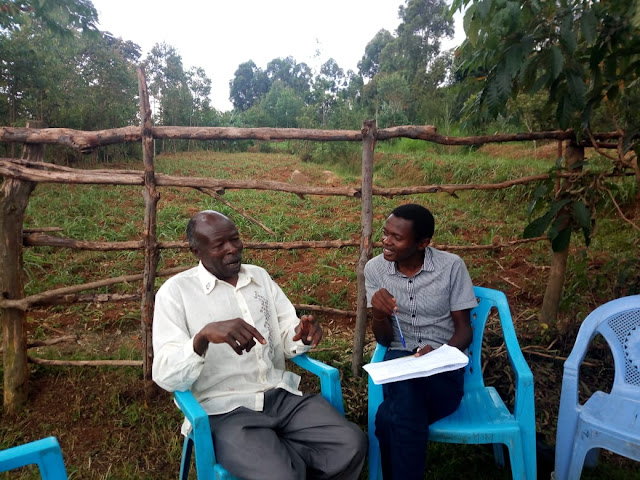The Ndanyi
 |
| With Harry Ndanyi at their home in Gavalagi village |
Ndanyi's are found at Gavalagi (muhanda), off Vihiga-Bunyore road. They are the sons of Elisha Ndanyi. The son of Matayo Ndanyi. The son of Mudave. The son of Ndasia. The son of Ang'ondu. Ang'ondu whose roots are in Inyanza, bordering Nyahera.
Ndasia is said to have been born at Chavwari, Kegendirova. Ndanyi's still have pieces of land there. Ndasia is mentioned alongside Olindo and Chabuga of Gambogi. If not all the descendants of Ang'ondu, then probably the descendants of a near ancestor.
Ndasia begot Mudave with an elder wife, Ang'undu with a younger one. His home was at iManda. The Ang'undu are found there. It is Mudave that begot a likely light and soft skinned Matayo Ndanyi circa 1882. Matayo's mother was Sara Avisa, muTemburi. The brother to Matayo Ndanyi had a name, Zedekiah Ang'undu who is at Kisugunwa (Gavalagi), not distant from Muhanda.
In 1906, the Friends United missionaries occupied Vihiga. Prior an Anglican base. As Nyang'ori was a white man's land that welcomed missionaries who wanted to access north Kavirondo. Friends people arrived at Nyang'ori first. Moved to Vihiga and finding there was no room for expansion, news of Kaimosi became golden with Rees having climbed a tree and seen a garden as of Eden.
Matayo would be trained in the first bunch of believers to the Friends faith. A conviction that filled him so to send his first son to a missionary school in Maseno - Elisha Ogada Ndanyi.
Elisha Ogada Ndanyi is known for his versatility as a teacher and prowess in music, singing and writing lyrics. He was a tutor at Kaimosi, became a founder teacher in several schools among them Munzatsi, Mazigulu, Kivagala, Tigoi, Vigina, Vihiga, Chango, Chambiti and Gavalagi for retirement. He was able to follow up and know the movements of vaSaniaga, a thing he recorded in a book that is now said to be lost. As a teacher, he was known for music, singer and pianist. "Tsinyimbu ziu Kwitsominya" had one hundred and eleven songs, his translations contribution. With schools, he shone at National Music Festivals, winning accolades yearly. He also lived in Nairobi and is a founder member of Buruburu Friends Church.
Matayo still had a life to live and dreams to pursue. One was in getting land and settling. Even if it meant away. Elisha and Tadayo at Maseno, he took off with his wife, Phoebe Makungu, muYonga, to Kisii. With only Ksh 45/-, at Bware, Matayo got land in comparison lengthwise Gisambai to Kima and of Boyani to Chavakali breadth. We are speaking of 1930's when settling and land acquisition was not a hard hustle. How Ndanyi found himself in Kisii could be through church friends. With at least 2,000 ha, our grandfather was good to settle.
But death is a great thief and distabilizer. The first two children of Ndanyi had died young at iManda. They were twins. Elisha was then born a Kisia. Going to Kisii, two children died there in circumstances described as hostile and of poor receptivity by the locals. It was thought witchcraft. Seeing that, it was best to migrate than wait for deaths. And as migrations immemorial, you leave all and run for life. Bware was left so, Matayo back at iManda. Phoebe's sister, Maria Atiamuga married to Arenga, muSaniaga kandi, was happy to see her sister back and live. The two kept tabs often.
With two shillings, he bought the sloppy land where Elisha and Tadayo would settle. Elisha worked to add more land there. Benjamin was given the iManda share. Elam Edambo migrated to Lugare. Tafroza and Fenike of Tigoi and Madzu courts were the sisters that grew to age.
Elisha married mukana muKevembe, wi rigondo riravu ni isang'ari, mama Ebby Ivayo. She was a great pillar to the successes of Elisha and the raising of twelve children. Arthur, Alice, Florence, Lona, Harry, Joseph, Helen, Charles, Samson, John, Linet and Thomas are now of good years, counting grandchildren.
-/With Thanks
Saniaga.org
Saniaga.blogspot.com
Comments
Post a Comment